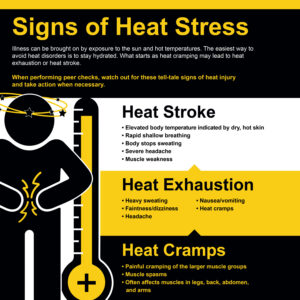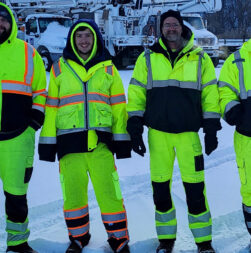At Flagger Force, safety doesn’t clock out at the end of the shift, it starts before the sun comes up and lasts long after the work zone tear down. As summer temperatures climb, taking extra steps to protect yourself and your crew from the risks of heat stress is essential.
Understanding how heat affects your body and preparing for it before you even clock in can make all the difference. That’s why we’re talking about how to stay ahead of heat-related illness through hydration, awareness, and smart habits.
Let’s learn how to keep cool when the heat is on!
Hydration Starts the Night Before
Staying safe in the summer heat begins long before the workday starts. In fact, one of the most important steps you can take is to hydrate the night before. Your body needs time to absorb water and send it where it’s needed most, like your muscles and bloodstream. That process doesn’t happen instantly, which is why evening hydration is key.
Luke Lazar, Vice President of Risk & Safety, recommends drinking at least 8 ounces of water every hour for three to four hours after your workday. If you’ve been sweating heavily or working in direct sun, consider adding an electrolyte drink or eating a salty snack to help your body retain fluids and restore balance.
Hydrating the night before helps you:
- Rebuild fluid levels lost during the day
- Prepare your body to handle the next day’s heat
- Reduce the risk of waking up dehydrated or fatigued
- Start your day with energy and focus instead of playing catch-up
Make hydration part of your evening routine, just like charging your phone or laying out your gear. Your body and your crew will thank you for it in the morning. While hydration is your first line of defense, smart habits throughout the day are just as important.
Heat Safety Tips from the Field
Our field teams stay ready for the heat by leaning into smart practices that make a big impact. Through ITZ, our internal communications platform, we’re sharing reminders and resources to keep safety top of mind. Some key strategies include:
- Wearing UPF-rated clothing
- Using sunscreen and reapplying throughout the day
- Rotating breaks in shaded areas
- Watching for signs of heat illness in yourself and your teammates
- Drinking both water and electrolyte-based fluids steadily throughout the day—every 15-20 minutes on the job
A well-hydrated body is your best defense against the summer sun.
Know the Signs: Heat Illness Symptoms to Watch For
Being aware of how your body feels in the heat, and looking out for your crew can help prevent a serious medical emergency. Heat illness can progress quickly if ignored, so it’s important to catch symptoms early.
Staying safe in the heat isn’t just about you, it’s about looking out for your entire crew. Share these tips, stay hydrated, and let’s keep each other safe this summer.
Here’s what to watch for:
- Heat Exhaustion
- Heavy sweating
- Weakness or fatigue
- Dizziness or fainting
- Headache
- Nausea or vomiting
- Cool, pale, or clammy skin
- Muscle cramps
If you or anyone on your crew is experiencing these signs or symptoms, move to a cooler area, slowly sip water or an electrolyte drink, loosen clothing, and apply cool compresses.
If you or a member of your crew is experiencing any of the following signs or symptoms, call 911 immediately.
- Body temperature of 103 degrees or higher
- Red, hot, and dry skin with no sweating
- Rapid, strong pulse
- Confusion or slurred speech
- Seizure or loss of consciousness

Be the Reason Someone Gets Home Safe
Each of us has a “why” for staying safe. Our families, our futures, and our fellow crew members. Recognizing when someone isn’t feeling right, calling out unsafe conditions, or encouraging a teammate to take a break can be the difference between a regular day and a medical emergency.
So, ask yourself: What’s your “why” for staying cool and safe in the heat?

